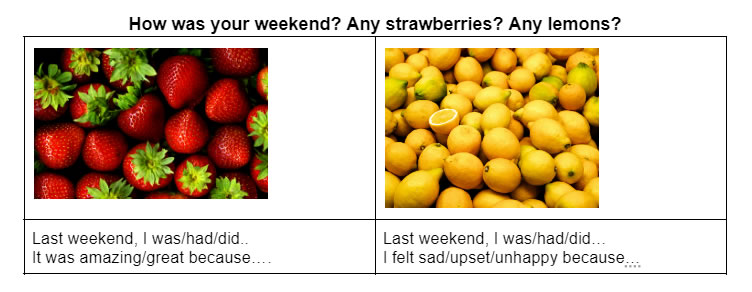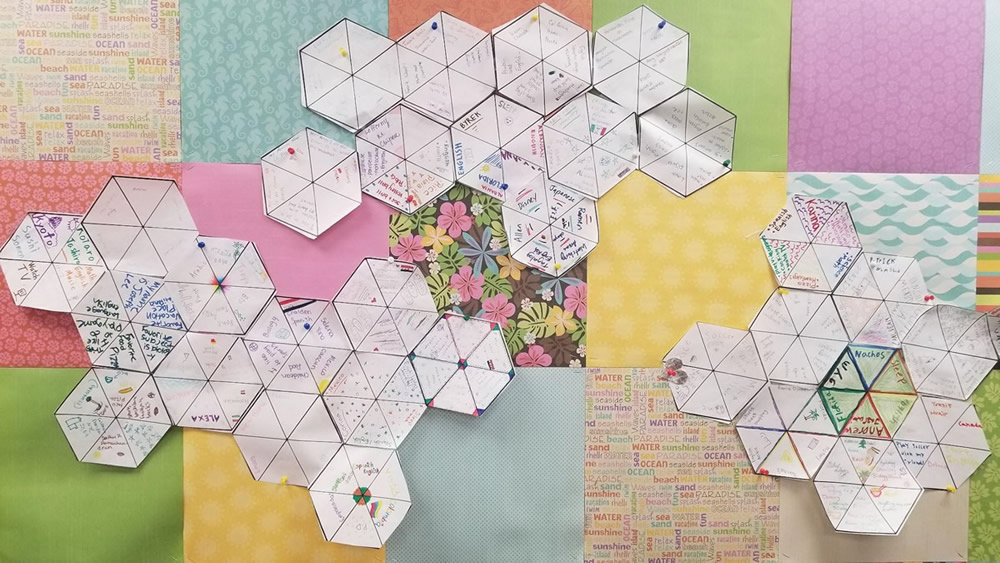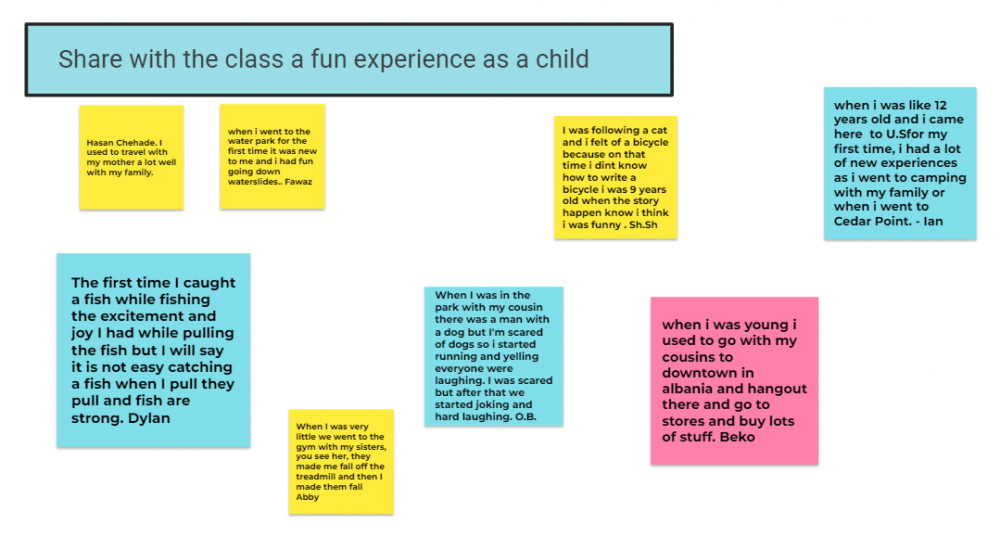An SEL Toolbox for the English Language Classroom
by Yevgeniya Pukalo and Kelsey DeCamillis
 In the 2020–2021 school year, teachers
across the world found themselves working mostly remotely from their kitchens,
bedrooms, and basements; we were trying our best to keep our students engaged
and focused. We faced many issues because of the trauma that impacted the
emotional maturity and health of our students that bled into the
2021–2022 school year as well. At Yevgeniya’s school in
Southeastern Michigan, we found there were some specific trauma-related issues
that we identified as being the most prevalent in our students:
In the 2020–2021 school year, teachers
across the world found themselves working mostly remotely from their kitchens,
bedrooms, and basements; we were trying our best to keep our students engaged
and focused. We faced many issues because of the trauma that impacted the
emotional maturity and health of our students that bled into the
2021–2022 school year as well. At Yevgeniya’s school in
Southeastern Michigan, we found there were some specific trauma-related issues
that we identified as being the most prevalent in our students:
- Disconnect and lack of community
- Confusion and overwhelm
- Low motivation and focus
- Struggle with academics
- Loss of peer relationships
In addition to these general issues across the
board with all students, there were many new challenges brought on in the
English language classroom during the pandemic-response online learning year.
Language learning was hindered in many ways in the shift to online learning,
with issues ranging from access to the internet, a lack of technology, and
decreased family support and motivation to practice a new language to
classroom-specific problems like isolation from peers. At the same time as
these obstacles presented themselves, a window of opportunity opened that
allowed us to discover creative solutions to these issues and to focus on
social-emotional learning (SEL) needs of students in the English language
classroom. In light of the collective trauma that we were all going through, it
became imminently important to focus on the emotional welfare of students and
to build their SEL capacity.
After collaborating with her colleagues, Yevgeniya
began to build a toolbox with various SEL strategies, using it to store
favorite activities that worked for her students virtually or in-person and
adding or creating new ones when old activities and strategies no longer
worked. Over the course of the past 2 years in building this toolbox, she found
that there were a few key categories of SEL tools:
- Tools to build rapport
- Digital tools
- Tools to assess student SEL
Following, Yevgeniya will share some of the key
activities that helped promote SEL in her classroom, including a link to our
2022 TESOL International Convention & English Language Expo
presentation, which contains much more of the “SEL
toolbox,” complete with links and examples.
Tools to Build
Rapport
Emotion
Check-Ins
These tools are typically used at the beginning of a class
session to provide an opportunity for connection and relationship building.
They were especially helpful in trying to connect with students remotely but
are easily adapted to work in-person as well.
1. Lemons and
Strawberries (Ups and Downs)
Ask students to specifically share whether they had any ups
(strawberries) or downs (lemons). This is a great way to start a lesson after a
break or a weekend. It allows students to share and be respectful listeners.
For students with emerging English proficiency, teachers can have a couple of
sentence starters on the board (see Figure 1).
Note: In different cultures, different fruits hold
varying cultural values. Consider opening this activity the first time with a
class discussion of what fruits or other symbols might represent highs and lows
for each student’s home culture.

Figure 1. Lemons and Strawberries activity and sentence
frames. (Click here to enlarge)
2. What Squirrel Are You Today?
Have students rate their daily feelings using real-life
images (see Figure 2). This is one of my favorite activities to see how
everyone is doing. It doesn’t require any serious preparation, but it
reveals a lot about how your students are feeling. It can help you learn about
your students’ emotional state and, by providing more emotion options
(than, e.g., just a smiley face or frowning face), you get a sense of how they
are more honestly feeling.

Figure 2. Squirrel emotion scale chart.
Recognizing Healthy Social-Emotional Behavior
Providing positive reinforcement is an important
element of teaching healthy social-emotional skills. These tools encourage
students to put their social-emotional skills to work by providing recognition.
3. Pineapple Award
(Student of the Month)
If you “catch” students doing good
deeds, they are candidates to get the Pineapple Award. This encourages students
to practice their SEL skills actively, hoping to be noticed and have the chance
to be recognized as the student of the month. You can give out a little gift (I
have pineapple pens I found online), and student winners get their picture on
the wall in recognition (see Figure 3).

Figure 3. Pineapple Award recognition wall. (Click here to enlarge)
4. “I
hope…” Notes
At the beginning of the year, have students write about
their hopes to encourage a positive outlook and provide a chance for goal
setting. Post them in the classroom as a reminder to students of their hopes
throughout the year (see Figure 4). At the end of the school year, students
revisit their hopes and then write a reflection about whether their hopes were
fulfilled; this way, they recognize their past perspective and how they have
grown or shifted perspective over the year. Here are some student examples;
they are unedited:
- I hope to
get good grades.
-
I hope that i make
more friends.
- I hope that I can
smile every day.
-
I hope to increase
my English level.

Figure 4. “I hope” notes posted in the classroom. (Click here to enlarge)
It can be a good practice to have students write
one academic hope and one social hope.
Tools to Build Empathy and Community
5. Scavenger Hunt
This was a popular activity with beginning English learners
during virtual learning. Ask students to find an object at home, with specific
characteristics, to show everybody (see Figure 5). For example, ask them to
find something green or something square. It’s fast and fun. It
allows English learners to practice English (vocabulary review, following
directions, speaking and listening skills) while connecting with their
classmates in a way that shows a glimpse into their life. This could easily be
shifted to in-person by making it an assignment to bring something into school,
like a show-and-tell.

Figure 5. Virtual learning home scavenger hunt.
6. We Share Something
in Common (Hexagon Activity)
Students fill out six triangles based on prompts/categories
you give them (e.g., favorite color, languages they speak, countries they come
from). Then, they work together to see any similarities. Where there are
similarities, they match the edges of their hexagons up and tape them together
on the back: They match and build connections with their classmates (see Figure
6). It’s a crafty way for students to build empathy and see
connections between one another they might not have seen before.

Figure 6. Hexagon activity displayed on wall. (Click here to enlarge)
Digital Tools for SEL
Another way to support student SEL is by using the
variety of digital tools that exist. During virtual teaching and learning,
everybody was overwhelmed with the amount of technology we used, and we ran
into plenty of tech issues and complications—too many tabs, too many
learning platforms, eventually even too many screens! After the deluge, the
following tools proved to continue helping support students, building some SEL
skills, and providing language practice as well.
7. Jamboard
Jamboard is a great Google whiteboard tool that keeps
students engaged and allows real-time communication. Jamboard quickly became
one of my favorite tools to teach content, have discussions on various topics,
and do quick SEL checks. Specifically, because it can be made anonymous to the
other students, learners’ sense of safety in sharing on the Jamboard
is increased.

Figure 7. Jamboard showing students sharing stories in
anticipation of writing a memoir. (Click here to enlarge)
You can give students prompts that will encourage
positive reflection on themselves and their lives, and that can prepare them
for future assignments, such as “Share with the class a fun
experience as a child” in anticipation of writing a memoir (see
Figure 7). Questions like “What are five words I would use to
describe myself?” are affirmation activities and also offer practice
reviewing parts of speech (adjectives).
8. Poetry and
Journaling
Another way you can engage students in social-emotional work
is through journaling. In online teaching, provide them with a virtual journal
and have them respond to prompts such as “I am” poems.
Jason Reynolds’s “Write, Right, Rite” project is
an excellent video resource for these activities. Reynolds, the U.S. National
Ambassador for Young People’s Literature, gives fun, brain-break worthy
challenges to the students, like “Take an Imaginary Road
Trip.”
Tools for Assessing Social-Emotional Learning
From lesson planning to teaching, I have been using
the following tools to assess the SEL needs of my students in real time, even
when we were in a virtual classroom. These assessment tools allow you to
monitor your students’ learning, language development, and their SEL
needs. Some of these overlap as great digital tools, as well.
9. SEL Reflection
Prompts
These SEL Reflection Prompts are a great way to assess
specific areas of SEL, and they also offer great writing practice. They are
provided by Collaborative for Academic, Social, and Emotional Learning (CASEL),
the leading organization on implementing SEL in classes across the nation. I
used them often as entrance slips to class. Here are a few of the prompts, from
the category “prompts that support social awareness and relationship
skills” and questions that help to “recognize the feelings
and perspectives of others”:
-
Write
about a time you disagreed with a friend. How did you handle it?
-
What are some
things you can do to be an active listener?
-
Why is it valuable
to learn about the perspectives of others?
-
Write about a time
that your opinion changed. What caused it to change?
-
Write about a
current event and analyze the perspectives of different people involved,
including how their life experiences/ identity may impact their perspectives.
-
Analyze the
factors that have influenced your perspective on an issue.
(CASEL, 2020)
10. Exit Slips
Similarly to the CASEL prompts, these Friendzy Exit Ticket
Slides are an extremely helpful tool in measuring specific SEL skills while
also providing a chance for students to work on their writing skills. In the
notes section of each slide, it is indicated which SEL skill is being assessed
by the prompt.
Conclusion
Through trial and error, collaboration with
colleagues, observation of engagement, and assessment of the SEL skills of my
students, I have found that these SEL tools work, and I will continue to work
on adding to this toolbox over time. There are many more amazing tools in my
SEL toolbox that I didn’t touch on in this article; you can explore
them in my presentation from the 2022 TESOL International Association & English Language Expo. I definitely recommend checking out the
rest of the tools that are provided in the slides, especially Slides 26 and 27,
which contain a fantastic SEL activities list that Farmington Public Schools
allowed me to share for this presentation.
The shift to emergency online teaching during the
pandemic taught us valuable lessons about the social-emotional welfare of our students,
and I hope these tools help you build those SEL skills in your own English
language classroom. For more research on SEL, we recommend looking into CASEL,
trauma-informed practices (Crosby et al., 2018), and mindfulness (Bishop et
al., 2004; Kabat-Zinn, 2013; McCown et al., 2010) as starting points.
References
Bishop, S. R., Lau, M., Shapiro, S., Carlson, L.,
Anderson, N. D., Carmody, J., Segal, Z. V., Abbey, S., Speca, M., Velting, D.,
& Devins, G. (2004). Mindfulness: A proposed operational definition. Clinical Psychology: Science and Practice, 11(3), 230–241.
Collaborative for Academic, Social, and Emotional Learning. (2020). SEL reflection prompts. https://casel.s3.us-east-2.amazonaws.com/SEL-Reflection-Prompts.pdf
Crosby, S. D., Howell, P., & Thomas, S.
(2018). Social justice education through trauma-informed teaching. Middle
School Journal, 49(4), 15–23.
Kabat-Zinn, J. (2013). Full catastrophe living,
revised edition: How to cope with stress, pain and illness using mindfulness
meditation. Hachette.
McCown, D., Reibel, D., & Micozzi, M. S.
(2010). Defining mindfulness for the moment. In Teaching mindfulness: A
practical guide for clinicians and educators (pp. 59-87). Springer.
Yevgeniya Pukalo is currently an ESL/ELA teacher at North
Farmington High School (Farmington Public Schools, Michigan, USA). Yevgeniya
has experience teaching K–12 English learners as well as adult
learners. She has a BA in English and an MA in TESOL.
Kelsey DeCamillis (MA, TESOL) currently works as a literacy
interventionist and has had many teaching experiences in the realm of TESOL,
teaching English from elementary up through university and adult learners and
in many contexts (EFL abroad in South Korea and Montenegro; EAL, ELA, and CBI
as well as instructional coaching in Southeastern Michigan, USA).